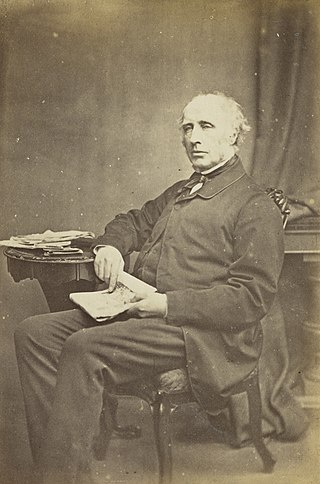
The Gordon Riots of 1780 were several days of rioting in London motivated by anti-Catholic sentiment. They began with a large and orderly protest against the Papists Act 1778, which was intended to reduce official discrimination against British Catholics enacted by the Popery Act 1698. Lord George Gordon, head of the Protestant Association, argued that the law would enable Catholics to join the British Army and plot treason. The protest led to widespread rioting and looting, including attacks on Newgate Prison and the Bank of England and was the most destructive in the history of London.

The Most Ancient and Most Noble Order of the Thistle is an order of chivalry associated with Scotland. The current version of the Order was founded in 1687 by King James VII of Scotland, who asserted that he was reviving an earlier Order. The Order consists of the Sovereign and sixteen Knights and Ladies, as well as certain "extra" knights. The Sovereign alone grants membership of the Order; they are not advised by the Government, as occurs with most other Orders.

Glen Innes is a parish and town on the Northern Tablelands, in the New England region of New South Wales, Australia. It is the centre of the Glen Innes Severn Shire Council. The town is located at the intersection of the New England Highway and the Gwydir Highway. At the 2016 census, Glen Innes had a population of 6,155.
The Bishop of Galloway, also called the Bishop of Whithorn, was the eccesiastical head of the Diocese of Galloway, said to have been founded by Saint Ninian in the mid-5th century. The subsequent Anglo-Saxon bishopric was founded in the late 7th century or early 8th century, and the first known bishop was one Pehthelm, "shield of the Picts". According to Anglo-Saxon ecclesiastical tradition, the bishopric was founded by Saint Ninian, a later corruption of the British name Uinniau or Irish Finian; although there is no contemporary evidence, it is quite likely that there had been a British or Hiberno-British bishopric before the Anglo-Saxon takeover. After Heathored, no bishop is known until the apparent resurrection of the diocese in the reign of King Fergus of Galloway. The bishops remained, uniquely for Scottish bishops, the suffragans of the Archbishop of York until 1359 when the pope released the bishopric from requiring metropolitan assent. James I formalised the admission of the diocese into the Scottish church on 26 August 1430 and just as all Scottish sees, Whithorn was to be accountable directly to the pope. The diocese was placed under the metropolitan jurisdiction of St Andrews on 17 August 1472 and then moved to the province of Glasgow on 9 January 1492. The diocese disappeared during the Scottish Reformation, but was recreated by the Catholic Church in 1878 with its cathedra at Dumfries, although it is now based at Ayr.

Cosmo Nelson Innes FRSE was a Scottish advocate, judge, historian and antiquary. He served as Advocate-Depute, Sheriff of Elginshire, and Principal Clerk of Session.
Thomas Innes was a Scottish Roman Catholic priest and historian. He studied at the Scots College, (Paris), of which he became vice-principal. He was the author of two learned works, Critical Essay on the Ancient Inhabitants of the Northern Parts of Britain (1729), and Civil and Ecclesiastical History of Scotland, 80 to 818.

Holiday Inn Express is an American-based mid-priced hotel chain within the InterContinental Hotels Group family of brands. Originally founded as an "express" hotel, their focus is on offering limited services at a reasonable price. Standard amenities lean toward the convenient and practical which cater to business travelers and short-term stays. As of September 2019, there are 2,826 Holiday Inn Express hotels featuring over 292,000 rooms worldwide.

Ponteland is a large village and civil parish in Northumberland, England. It is 15 miles (24 km) north of Newcastle upon Tyne. The name means "island in the Pont", after the River Pont which flows from west to east and joins the River Blyth further downstream, before flowing into the North Sea.
The Review of Metaphysics is a peer-reviewed academic journal of philosophy. It was established by Paul Weiss and the first issue was published in September 1947. The journal's primary sponsor is and has been The Catholic University of America, but other major universities help sustain it.
Fr Ian Anthony Ross was a Scottish born Catholic priest and member of The Order of Preachers (Dominican). He was also a noted broadcaster, writer, community activist, educator and antiquarian who served as Rector of the University of Edinburgh (1979–1982).

The Catholic Historical Review (CHR) is the official organ of the American Catholic Historical Association. It was established at The Catholic University of America in 1915 by Thomas Joseph Shahan and Peter Guilday and is published quarterly by The Catholic University of America Press. The first issue contained a foreword by Cardinal James Gibbons who wrote of the journal that "I bespeak for it a generous welcome by the thoughtful men and women of the country, and bestow my blessing on the unselfish, zealous labors of the devoted Faculty of the Catholic University." Nelson Minnich is the editor.

The Journal of the History of Ideas is a quarterly peer-reviewed academic journal covering intellectual history, conceptual history, and the history of ideas, including the histories of philosophy, literature and the arts, natural and social sciences, religion, and political thought.
The Scottish Historical Review is a biannual academic journal in the field of Scottish historical studies, covering Scottish history from the early to the modern, encouraging a variety of historical approaches. It superseded The Scottish Antiquary, Or, Northern Notes & Queries.

The Journal of Scottish Historical Studies is a bi-annual peer-reviewed academic journal published by Edinburgh University Press on behalf of the Economic and Social History Society of Scotland in May and November of each year. It was established in 1980 as Scottish Economic and Social History and took its current title in 2004. It covers research on the history of Scotland.

Architecture in modern Scotland encompasses all building in Scotland, between the beginning of the twentieth century and the present day. The most significant architect of the early twentieth century was Charles Rennie Mackintosh, who mixed elements of traditional Scottish architecture with contemporary movements. Estate house design declined in importance in the twentieth century. In the early decades of the century, traditional materials began to give way to cheaper modern ones. After the First World War, Modernism and the office block began to dominate building in the major cities and attempts began to improve the quality of urban housing for the poor, resulted in a massive programme of council house building. The Neo-Gothic style continued in to the twentieth century but the most common forms in this period were plain and massive Neo-Romanesque buildings.
The Church of St Margaret of Scotland, also known as St Margarets Catholic Church, is a Roman Catholic church on St Margaret's Road in St Margarets, Twickenham, in the London Borough of Richmond upon Thames. The parish was created in 1936. The church building was designed by the architect Austin Winkley who was an influential architect of the Liturgical Movement. It opened in 1969. In 1999 it became a Grade II listed building.

Hospitality International is a chain of hotels and motels in the United States and Canada. Their brands include Red Carpet Inn and Scottish Inns.

Greyfriars Sisters of Mercy Convent in Elgin, Moray is one of the few Catholic monasteries, founded in Scotland after the Reformation in 1560.

The Old Course Hotel, or its full name, the Old Course Hotel, Golf Resort & Spa, is a five-star hotel in St Andrews, Fife, Scotland.
James Henderson Burns was a Scottish historian of medieval and modern political thought who also studied utilitarianism and Jeremy Bentham.












